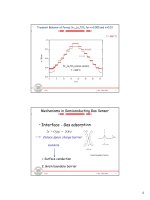nanoporous materials science and engineering (series on chemical engineering)
Bạn đang xem bản rút gọn của tài liệu. Xem và tải ngay bản đầy đủ của tài liệu tại đây (43.77 MB, 917 trang )
Nanoporous
Materials
Science and Engineering
edited by
G.
Q. Lu
University
of
Queensland,
Australia
X. S. Zhao
National University
of
Singapore,
Singapore
Imperial College Press
Published by
Imperial College Press
57 Shelton Street
Covent Garden
London WC2H 9HE
Distributed by
World Scientific Publishing Co. Pte. Ltd.
5 Toh Tuck Link, Singapore 596224
USA office: 27 Warren Street, Suite 401^02, Hackensack, NJ 07601
UK office: 57 Shelton Street, Covent Garden, London WC2H 9HE
British Library Cataloguing-in-Publication Data
A catalogue record for this book is available from the British Library.
NANOPOROUS MATERIALS: SCIENCE AND ENGINEERING
Series on Chemical Engineering
Copyright © 2004 by Imperial College Press
All rights
reserved.
This
book,
or parts
thereof,
may not be reproduced in any form or by any means, electronic or
mechanical, including photocopying, recording or any information storage and retrieval system now known or to
be
invented,
without written permission from the Publisher.
For photocopying of material in this volume, please pay a copying fee through the Copyright Clearance Center,
Inc.,
222 Rosewood Drive, Danvers, MA 01923, USA. In this case permission to photocopy is not required from
the publisher.
ISBN
1-86094-210-5
ISBN
1-86094-211-3
(pbk)
Editor: Tjan Kwang Wei
Printed in Singapore
by World
Scientific Printers (S) Pte Ltd
Preface
In the last decade, we have witnessed a rapid growth in research and
development of nanotechnology, especially nanostructured materials.
Nanoporous materials as an important class of nanostructured materials
possess high specific surface area, large pore volume, uniform pore size,
and rich surface chemistry. These materials present great promises and
opportunities for a new generation of functional materials with improved
and tailorable properties for applications in adsorption, membranes,
sensors, energy storage, catalysis and photocatalysis, and biotechnology,
etc.
Interest in making materials from nanoscale building blocks arose from
discoveries that by controlling the size in the range of 1-100 nm and the
assembly of such constituents, one could alter and prescribe the properties
of the assembled nanostructures. Nanoscale phenomena and objects have
been around for some time. Catalysts, for example, are mostly nanoscale
particles, and catalysis is a nanoscale phenomenon. What is new and
different now is the degree of understanding and deliberate control and
precision that the new nanoscale techniques afford. Instead of discovering
new materials by random search (trial-and-error), we can now design them
systematically. Nanoporous materials can have long-range structural order
or disordered structure and contain pores of the dimension of a few
nanometers to tens of nanometers. Some applications such as catalysis
take advantage of high surface area and pore confinement effects.
Synthesis and processing of nanoporous materials with controllable
structures and properties require new approaches such as molecular
templating and intercalation in a bottom-up manner.
From a practical standpoint, a large specific surface for nanoparticles is
most desired for catalysis. However, fine powder catalysts can cause
serious operational problems such as agglomeration, difficulties in
loading, pressure drop, and separation of catalyst from the reaction
products. A feasible approach to generating a large and accessible surface
area of catalyst but avoiding the morphology of fine powder is to create a
composite or immobilized structure. One can disperse nanoparticles of
metals or oxides in an inorganic support to stabilize the discrete
nanoparticles, meanwhile maintaining most of their surface accessible to
reactant molecules. However, the conventional methods of preparing the
catalysts such as impregnation often result in agglomerated catalyst
particles in the support, thus decreasing the active surface area, and
uniformity of the active centers. With nanostructuring techniques, active
metal or oxide precursors can be incorporated or grafted on the
nanoporous support during synthesis thus not only increase the control in
catalyst particle size, surface area and dispersion, but also eliminating the
cost and problems associated with impregnation.
Since the early 1990s, a large number of microporous and mesoporous
materials have found wide applications in catalysis. Major breakthroughs
in materials synthesis such as the templated synthesis of mesoporous
molecular sieves M41S and porous clay heterostructures have opened
exciting avenues for designing new classes of nanoporous materials based
on molecular templating and self-assembly principle (with pore
dimensions between 1 to 10 nm). These materials offer great potential for
applications in separation and catalysis, particularly reactions involving
large and bulky molecules. We are excited at the prospect of an explosion
of revolutionary discoveries at nanoscale. The new millennium presents
opportunities as well as challenges to scientists and engineers working in
this dynamic field of nanoporous materials in terms of the tailor-design,
synthesis and characterization for specific functionalities and applications.
The main objectives of this book are to provide the readers with an
overview of the field of nanoporous materials and to present the latest
advances in various areas from synthesis, characterization, surface
modification to adsorption and separation processes, and biological and
catalytic applications. Fundamentally, this book contains chapters dealing
with important issues in synthesis of nanoporous materials of various
compositions, characterization techniques, surface modification/
functionalization, catalyst design and nanostructure tailoring, and
adsorption/separation application including bioseparation. This book
presents 28 comprehensive chapters reviewing the state of the art in the
field of nanoporous materials contributed by some of the finest scientists
in the world in this field.
With an overview of nanoporous materials in chapter 1, chapters 2-10
describe some general strategies for the synthesis of nanoporous materials
such as the nonionic block copolymer template method, the synthesis of
composite materials with a zeolite framework, preparation of hydrophobic
membranes using sol-gel technique, macroporous materials templated by
colloidal crystals, and carbon nanotubes. The advances in characterization
of nanoporous materials by physical adsorption in combination with
simulation, and modification and functionalization of nanoporous
materials are covered in chapters 11-16. In addition to traditional pore
evaluation methods such as the BJH method based on Kelvin equation for
pore size determination, the development of microscopic methods, such as
the non-local-density functional theory (NLDFT) or computer simulation
methods (e.g. monte-carlo and molecular-dynamic simulations), which
allow the description of the configuration of adsorbed molecules in pores
on a molecular level (elaborated in chapters 11 and 12). Surface
functionalization of nanoporous materials by grafting, co-condensation
routes, and molecularly designed dispersion methods, surface alumination
to alter acidity, as well as measurement of surface acidity can be found in
chapters 13-16. Recent developments in the catalytic applications of
nanoporous materials, ranging from acidic catalysis to base catalysis, from
shape-selective catalysis to environmentally friendly catalysis, are
presented in chapters
17-21.
Adsorption- and separation processes
involving nanoporous materials are subjects of chapters 22-28.
Nanoporous materials for the removal of pollutants in gas or liquid phase
are elaborated. Separation and immobilization of enzymes are reviewed in
chapters 26 and 27.
We would like to thank the authors of the chapters for their valuable and
timely contributions, and for their patience and cooperation in the editing
process. We hope that this book would be a useful reference for senior
students, graduate students and researchers in materials chemistry,
physical and colloid chemistry, chemical engineering, materials science,
biotechnology and nanotechnology.
Finally, we would like to express our sincere thanks to Professor Ralph T
Yang, University of Michigan, the Series Editor of Chemical Engineering
for Imperial College Press for his kind invitation to contribute this volume.
We would also like to thank the Editor in Imperial College Press, Tjan
Kwang Wei for his great assistance. We are very grateful to Sharon
Mathiesen for her wonderful help with manuscript management and
editing. Last but not the least, to our respective families for their love,
understanding and support in this endeavor.
G.Q (Max ) Lu George X S Zhao
Brisbane, Australia Singapore
November, 2003
ix
This page has been reformatted by Knovel to provide easier navigation.
Contents
Preface v
1. Nanoporous Materials-an Overview 1
1.1 Introduction 1
1.2 Classification of Nanoporous Materials 4
1.3 Properties and Characterization of Nanoporous
Materials 5
1.4 Major Opportunities in Applications 6
1.5 Concluding Remarks 11
References 13
2. Advances in Mesoporous Materials Templated by
Nonionic Block Copolymers 14
2.1 Introduction 14
2.2 Siliceous Mesoporous Materials 16
2.3 Wall Structures of Mesoporous Materials Templated by
Amphiphilic Block Copolymers 22
2.4 Morphology of Mesoporous Materials Templated by
Block Copolymers 24
2.5 Non-siliceous Structures 28
2.6 Applications 33
2.7 Conclusion Remarks 38
2.8 Acknowledgements 38
References 39
3. Zeolite/Mesoporous Molecular Sieve Composite
Materials 47
3.1 Introduction 47
3.2 Mechanisms of Zeolite Germination 48
x Contents
This page has been reformatted by Knovel to provide easier navigation.
3.3 Synthesis Strategies for Zeolite/MMS Composites 51
3.4 Catalytic Properties 84
3.5 Future Challenges 90
3.6 Conclusion 93
3.7 Acknowledgements 93
References 93
4. Chromium-containing Ordered Nanoporous Materials 101
4.1 Introduction 101
4.2 Materials and Methods 103
4.3 Results and Discussion 106
4.4 Conclusion 118
4.5 Acknowledgements 119
References 119
5. Surfactant-templated Mesostructured Materials:
Synthesis and Compositional Control 125
5.1 Introduction 125
5.2 Synthesis Routes 126
5.3 Compositions of Mesostructured and Mesoporous
Materials 140
5.4 Conclusions and Outlook 151
5.5 Acknowledgments 152
References 152
6. Organic Host-guest Structures in the Solid State 165
6.1 Introduction 166
6.2 Host Design Principles 168
6.3 C
3
Symmetry and Halogen Halogen Interaction in
Host Design 170
6.4 Wheel-axle Host Lattice 177
6.5 Design of Layered Host: Crystal Engineering 179
6.6 Gas Storage in Interstitial Voids 182
6.7 Guest Selectivity in Inclusion 184
Contents xi
This page has been reformatted by Knovel to provide easier navigation.
6.8 Conclusions 185
6.9 Acknowledgement 185
References 185
7. Nonsurfactant Route to Nanoporous Phenyl-modified
Hybrid Silica Materials 188
7.1 Introduction 188
7.2 Methods 191
7.3 Results and Discussion 192
7.4 Conclusions 202
7.5 Acknowledgements 202
References 202
8. 3D Macroporous Photonic Materials Templated by
Self Assembled Colloidal Spheres 206
8.1 Introduction 206
8.2 A Survey of Photonic Bandgap 207
8.3 Nanolithography for Photonic Crystals 211
8.4 Self-assembly Approaches to 3D Photonic Crystals 212
8.5 Fabrication of Intentional Defects in 3D Photonic
Crystals 226
8.6 Acknowledgements 228
References 228
9. Hydrophobic Microporous Silica Membranes for Gas
Separation and Membrane Reactors 237
9.1 Introduction 237
9.2 Inorganic Membranes 238
9.3 Hydrothermal Stability and Hydrophobicity-key Areas of
Improvement 243
9.4 Membrane Reactors 251
9.5 Perspective and Concluding Remarks 256
9.6 Acknowledgement 257
References 257
xii Contents
This page has been reformatted by Knovel to provide easier navigation.
10. Synthesis and Characterization of Carbon Nanotubes
for Hydrogen Storage 263
10.1 Introduction 264
10.2 Construction, Structure and Unique Properties of
Carbon Nanotubes 266
10.3 Synthesis of Carbon Nanotubes 271
10.4 Surface and Pore Structure of Carbon Nanotubes 279
10.5 Experimental Investigations on Hydrogen Uptake in
Carbon Nanotubes 286
10.6 Theoretical Predictions and Simulations of Hydrogen
Uptake in Carbon Nanotubes 295
10.7 Possible Hydrogen Adsorption Sites in Carbon
Nanotubes 303
10.8 Future Research Topics and Remarks 308
10.9 Acknowledgement 309
References 309
11. Physical Adsorption Characterization of Ordered and
Amorphous Mesoporous Materials 317
11.1 Introduction 317
11.2 Surface and Pore Size Analysis by Physisorption:
General Aspects 322
11.3 Pore Condensation and Adsorption Hysteresis 328
11.4 Pore Size Analysis of Mesoporous Solids 345
11.5 Concluding Remarks 355
11.6 Acknowledgements 356
11.7 References 356
12. Molecular Simulation of Adsorption in Porous
Materials 365
12.1 Introduction 366
12.2 Simulation Techniques 366
12.3 Thermodynamics 369
12.4 Adsorption in Spaces with Simple Geometries 372
12.5 Adsorption Heterogeneity 380
Contents xiii
This page has been reformatted by Knovel to provide easier navigation.
12.6 Adsorption in Zeolites 382
Conclusions 387
References 387
13. Surface Functionalization of Ordered Nanoporous
Silicates 393
13.1 Introduction 394
13.2 Functionalization of ONSs by Grafting 396
13.3 Functionalization by co-condensation 407
13.4 Concluding Remarks 417
13.5 Acknowledgements 418
References 418
14. Surface Alumination of Mesoporous Silicates 427
14.1 Introduction 427
14.2 Direct Mixed-gel Synthesised Mesoporous
Aluminosilicates 428
14.3 Methods for the Surface Alumination of Mesoporous
Silicas 429
14.4 Acidity and Catalytic Activity of Al-grafted Mesoporous
Silicates 439
14.5 Stability of Al-grafted Mesoporous Aluminosilicates 446
14.6 Alumination of Mesoporous Silica via Composite
Materials 455
14.7 Concluding Remarks 457
14.8 Acknowledgements 458
References 458
15. Acidity Measurement of Nanoporous Aluminosilicates –
Zeolites and MCM-41 464
15.1 Introduction 464
15.2 Titration Methods 466
15.3 Thermodynamic Methods 468
15.4 Infrared Spectroscopic (IR) Methods 473
15.5 Nuclear Magnetic Resonance (NMR) Methods 477
xiv Contents
This page has been reformatted by Knovel to provide easier navigation.
15.6 Other Spectroscopic Methods 480
15.7 Concluding Remarks 482
15.8 Acknowledgements 483
References 483
16. Nanocatalysts Prepared by the Molecularly Designed
Dispersion Process 487
16.1 Introduction 487
16.2 Molecular Designed Dispersion Approach 488
16.3 Applications: Designed Dispersions of Metal Oxides on
Porous Solids 499
16.4 Conclusions 515
16.5 Acknowledgement 515
References 516
17. Acidity-enhanced Nanoporous Catalytic Materials 519
17.1 Introduction 519
17.2 Heteropolyacids (HPAs) Supported on Mesoporous
Materials 520
17.3 Sulfated Zirconia Supported on Mesoporous Materials 522
17.4 Acidity-enhanced Mesoporous Materials by
Posttreatments 527
17.5 Strongly Acidic Mesoporous Aluminosilicates
Assembled from Preformed Nanosized Zeolite
Precursors 537
17.6 Acknowledgements 546
References 546
18. Modified Mesoporous Materials as Acid and Base
Catalysts 553
18.1 Introduction 553
18.2 Synthesis of Materials 554
18.3 Acid Catalysts 557
18.4 Base Catalysis 575
18.5 Conclusions and Perspectives for Future Directions 586
Contents xv
This page has been reformatted by Knovel to provide easier navigation.
18.6 Acknowledgements 587
References 587
19. Lewis Acid/Base Catalysts Supported on Nanoporous
Silica as Environmental Catalysts 596
19.1 Introduction 596
19.2 Synthesis of Mesoporous Silicas with or without
Heterometallic Elements 597
19.3 Preparation and Characterization of Lewis Acid/Base
Containing Mesoporous Silica Catalysts 598
19.4 Application of Lewis Acid Catalysts Supported on
Mesoporous Silica 604
19.5 Applications of Basic Catalysts Supported on
Mesoporous Silica 611
19.6 Concluding Remarks 612
19.7 Acknowledgement 613
References 613
20. Nanoporous Catalysts for Shape-selective Synthesis
of Specialty Chemicals: a Review of Synthesis of 4,4’-
dialkylbiphenyl 623
20.1 Introduction 623
20.2 Shape-selective Preparation of 4,4'-diisopropylbiphenyl
(4,4'-DIBP) 627
20.3 Ethylation and Transethylation of Biphenyl and Its
Derivate into 4,4'-diethylbiphenyl (4,4'-DEBP) 634
20.4 Preparation of 4,4’-dimethylbiphenyl (4,4'-DMBP) 636
20.5 Conclusion 645
20.6 Acknowledgments 646
References 646
21. Catalysis Involving Mesoporous Molecular Sieves 649
21.1 Introduction 649
21.2 Acid/Base Catalysis 650
21.3 Redox Catalysis 660
xvi Contents
This page has been reformatted by Knovel to provide easier navigation.
21.4 Enantioselective Catalysis 668
21.5 Other Catalytic Applications 677
21.6 Acknowledgements 677
References 682
22. Adsorption and Transport in Nanoporous Materials 694
22.1 Introduction 694
22.2 Intraparticle Transport Mechanisms 695
22.3 Combined Bulk and Knudsen Diffusion 697
22.4 Viscous Flow 699
22.5 Diffusion within Micropores 703
22.6 Particle Uptake Rate Models 714
22.7 Conclusions 722
References 722
23. Adsorption of Organic Molecules in Nanoporous
Adsorbents from Aqueous Solution 727
23.1 Introduction 727
23.2 Characterisation of Nanoporous Adsorbents in View of
Their Use for Adsorption in Aqueous Solution 729
23.3 Thermodynamics and Kinetics of Adsorption in
Aqueous Solution 736
23.4 Other Methods 740
23.5 Applications 741
23.6 Conclusions 748
References 749
24. Functionalized Nanoporous Adsorbents for
Environmental Remediation 756
24.1 Introduction 756
24.2 Synthesis of Ordered Materials 757
24.3 Functionalization 760
24.4 Remediation 763
24.5 Conclusions 768
24.6 Acknowledgements 768
Contents xvii
This page has been reformatted by Knovel to provide easier navigation.
References 769
25. Nanoporous Adsorbents for Air Pollutant Removal 772
25.1 Introduction 772
25.2 Mechanism Approaches 773
25.3 Some Adsorbents Used in Air Treatments 786
25.4 Adsorption and Fixed Bed Adsorbers 788
25.5 Industrial Systems and Design Approaches 801
25.6 Activated Carbon Regeneration 805
References 809
26. Bioadsorption and Separation with Nanoporous
Materials 812
26.1 Introduction 812
26.2 Separations, Adsorption and Solutes 816
26.3 Adsorption Capacity and Kinetics 820
26.4 Access to Pores 824
26.5 Size Exclusion 827
26.6 Adsorption Mechanisms 829
26.7 Regeneration and Reuse 836
26.8 Stability 837
26.9 Challenges Remaining 839
26.10 Concluding Remarks 840
References 841
27. Nanoporous Materials as Supports for Enzyme
Immobilization 849
27.1 Introduction 849
27.2 Immobilization Methods for Enzymes 851
27.3 General Considerations in the Application of Nanoporous
Materials for Enzyme Immobilization 852
27.4 Microporous Molecular Sieves as Carriers 853
27.5 Mesoporous Molecular Sieves as Carriers 855
27.6 Mesocellular Foam (MCF) Materials as Carriers 866
xviii Contents
This page has been reformatted by Knovel to provide easier navigation.
27.7 Future Developments 868
27.8 Acknowledgements 870
References 870
28. A Novel Nonsurfactant Route to Nanoporous Materials
and Its Biological Applications 873
28.1 Introduction 873
28.2 Nonsurfactant-templating Route to Mesoporosity 874
28.3 Selected Applications of Nonsurfactant-templating
Approach 878
28.4 Nanoencapsulation of Enzymes and Other Bioactive
Substances 880
28.5 Protein Folding/Unfolding in Nanoporous Host
Materials and Rigid Matrix Artificial Chaperones 882
28.6 Summary 886
28.7 Acknowledgements 887
References 887
Author Index 893
Index 895
Chapter 1
NANOPOROUS MATERIALS - AN OVERVIEW
G. Q. LU
The Nanomaterials Centre, The University of Queensland, Brisbane 4072, Australia
E-mail:
X. S. ZHAO
Department of Chemical and Environmental Engineering, National University of
Singapore, 10 Kent Ridge Crescent, Singapore 119260
E-mail:
1 Introduction
In recent years, nanomaterials have been a core focus of nanoscience and
nanotechnology - which is an ever-growing multidisciplinary field of
study attracting tremendous interest, investment and effort in research and
development around the world. Nanoporous materials as a subset of
nanostructured materials possess unique surface, structural, and bulk
properties that underline their important uses in various fields such as ion
exchange, separation, catalysis, sensor, biological molecular isolation and
purifications. Nanoporous materials are also of scientific and technological
importance because of their vast ability to adsorb and interact with atoms,
ions and molecules on their large interior surfaces and in the nanometer
sized pore space. They offer new opportunities in areas of inclusion
chemistry, guest-host synthesis and molecular manipulations and reaction
in the nanoscale for making nanoparticles, nanowires and other quantum
nanostructures.
To provide a comprehensive overview of the area of nanoporous
materials, this chapter will begin with a brief introduction to nanoscience
and nanotechnology, and the importance of nanomaterials. The basic
concepts and definitions in relation to porous materials and nanoporous
materials will be given to understand the context of nanoporous materials.
Following this introduction, a systematical classification of the types and
scope of nanoporous materials will be presented. The properties and their
characterisation and measurement methods will be briefly described before
major applications in various fields are reviewed. Finally in this chapter,
key scientific and engineering issues and future directions are identified as
challenges and opportunities to researchers in this field.
1.1 Nanotechnology and nanomaterials
Nanoscale is fascinating because it is on this scale that atoms and
molecules interact and assemble into structures that possess unique
properties, which are dependent on the size of the structures. It is at this
scale that molecular interactions, processes, and phenomena can be
controlled and directed to form the desired geometries of the materials
building blocks with desirable properties. Nanoscale phenomena and
objects have, of course, been utilized for some time. Small metal or metal
oxide crystallites supported on a ceramic material, for example, are mostly
nanoscale particles that have been used to crack crude oil into fuels for
many years. However, what distinguishes cutting-edge nanoscience is the
degree of understanding, deliberate control, and precision that new
nanostructuring techniques afford. Instead of discovering new materials by
serendipity or by trial-and-error, we can now design them systematically.
Figure 1. Threshold of nanotechnology as basic sciences converges to the nanoscale
(adapted from [I])
The threshold
of a
revolution
in
the
ways
in
which materials
and products are created
-
nanotechnology
is
resulted due
to
the
convergence of
chemistry, physics and biology
Applications of
nanotechnology
Integrated
exploitation of
biological principles
physical laws
chemical properties
Electronic devices
Photonic devices
Sensors
Biochips
Supramolecular
chemistry
Complex
chemistry
Chemistry
Functional
molecule design
NA
NO
Molecular
biology
Quantum effects
Material
design
CeU biology
Biology
MI
CR
O
MA
CR
O
Micro-
electronics
Electronics
Electro
technology
Physics
Structure size
What makes nanoscale building blocks interesting is that by
controlling the size in the range of 1-100 nm and the assembly of such
constituents, one could alter and prescribe the properties of the assembled
nanostructures. As Professor Roald Hoffmann - the Chemistry Nobel
Laureate put it "Nanotechnology is the way of ingeniously controlling the
building of small and large structures, with intricate properties; it is the
way of the future, with incidentally, environmental benignness built in by
design". Nanostructured materials may possess nanoscale crystallites,
long-range ordered or disordered structures or pore space. Nanomaterials
can be designed and tailor-made at the molecular level to have desired
functionalities and properties. Manipulating matter at such a small scale
with precise control of its properties is one of the hallmarks of
nanotechnology. The potential and importance of nanoscale science and
technology has clearly been recognized worldwide as evidenced by
significant investments in nanotechnology R&D in the USA, Europe,
Japan and other Asia-Pacific countries since 2000 when the US Nation
Nanotechnology Initiative was announced.
12 Definitions of pores and porous materials
Porous materials are like music: the gaps are as important as the filled-in
bits.
The presence of pores (holes) in a material can render itself all sorts
of useful properties that the corresponding bulk material would not have
[2].
Generally porous materials have porosity (volume ratio of pore space
to the total volume of the material) between 0.2-0.95 [3]. Pores are
classified into two types: open pores which connect to the surface of the
material, and closed pores which are isolated from the outside. In
functional applications such as adsorption, catalysis and sensing, closed
pores are not of any use. In separation, catalysis, filtration or membranes,
often penetrating open pores are required. Materials with closed pores are
useful in sonic and thermal insulation, or lightweight structural
applications. Pores have various shapes and morphology such as
cylindrical, spherical and slit types. There are also pores taking more
complex shapes such a hexagonal shape. Pores can be straight or curved
or with many turns and twists thus having a high tortuosity.
The definition of pore size according to the International Union of
Pure and Applied Chemistry (IUPAC) is that micropores are smaller than
2 nm in diameter, mesopores 2 to 50 nm and macropores larger than 50
nm. However this definition is somewhat in conflict with the definition of
nanoscale objects. Nanoporous materials are a subset of porous materials,
typically having large porosities (greater than 0.4), and pore diameters
between 1- 100 nm. In the field of chemical functional porous materials, it
is better to use the term "nanoporous" consistently to refer to this class of
porous materials having diameters between 1 and 100 nm. For most
functional applications, pore sizes normally do not exceed 100 nm
anyway. It is noted that nanoporous materials actually encompass some
microporous materials to all mesoporous materials.
So what are the unique properties of those materials? Nanoporous
materials have specifically a high surface to volume ratio, with a high
surface area and large porosity, of course, and very ordered, uniform pore
structure. They have very versatile and rich surface composition, surface
properties, which can be used for functional applications such as catalysis,
chromatography, separation, and sensing. A lot of inorganic nanoporous
materials are made of oxides. They are often non-toxic, inert, and
chemically and thermally stable, although in certain applications the
thermal stability requirement is very stringent so you have to have a very
highly thermal stable catalyst.
2 Classification of Nanoporous Materials
Porous materials can be classified according to their materials constituents
(such as organic or inorganic; ceramic or metal) or their properties. Table
1 summarizes the available nanoporous materials according to their
chemical compositions and their technical characteristics.
Table 1. Classification of nanoporous materials
Polymeric Carbon Glass Alumino- Oxides Metal
silicate
Pore size Meso- Micro- Meso- Micro- Micro- Meso-
macro meso macro meso meso macro
Surface area / Low High Low High Medium Low
Porosity >0.6 0.3-0.6 0.3-0.6 0.3-0.7 0.3-0.6 0.1-0.7
Permeability Low- Low- High Low Low- High
medium medium medium
Strength Medium Low Strong Weak Weak- Strong
medium
Thermal Low High Good Medium- Medium- High
stability high high
Chemical Low- High High High Very High
stability medium high
Costs Low High High Low- Medium Medium
medium
Life Short Long Long Medium- Long Long
|
1 long
I |
3 Properties and characterization of nanoporous materials
Nanoporous materials possess a unique set of properties that the bulk
correspondent materials do not have such as high specific area, fluid
permeability and molecular sieving and shape-selective effects. Different
nanoporous materials with varying pore size, porosity, pore size
distribution and composition have different pore and surface properties
that will eventually determine their potential applications. For different
applications there are different sets of performance criteria that would
require different properties.
For example, the performance criteria for a good adsorbent include
(1) High adsorption capacity. Fundamental properties that affect this
parameter are specific surface area, surface chemical nature, and pore size.
These parameters determine how much adsorbates can be accumulated by
per unit mass of adsorbents.
(2) High selectivity. For multicomponent mixture, selectivity is highly
desired for separation. The selectivity of an adsorbent will depend on the
pore size, shape and pore size distribution as well as the nature of the
adsorbate components.
(3) Favorable adsorption kinetics. Adsorption kinetics is determined by
the particle (crystallite) size, the macro-, meso and microporosity of the
adsorbent. Sometimes, binder type and amount would also affect the
interparticle transport thus the global adsorption process kinetics. A
favorable kinetics means that the adsorption rate is fast or controllable
depending on the requirement of a particular application.
(4) Excellent mechanical properties. Obviously, adsorbents need to be
mechanically strong and robust enough to stand attrition, erosion and
crushing in adsorption columns or vessels. High bulk density and crushing
strength, and attrition resistance are desirable.
(5) Good stability and durability in use. Adsorbents are often subject to
harsh chemical, pressure and thermal environments. Good stability in
those environments is essential in ensuring long life or durable utilization.
As synthesized nanoporous materials may or may not have all these
desirable properties depending on the synthesis systems, methods and
processing conditions. Obviously the practical challenges in making good
adsorbent materials will be to obtain high-adsorption-capacity adsorbents
in a simple and cost effective manner, to make sure the above
requirements/criteria are met as much as possible. In many cases, post-
synthesis modification is required to impart certain functionality or
improve certain property due to the inability of the synthesis route to
achieve them during the process of synthesis. There are many research
efforts devoted to this area.
If used as catalyst support or catalysts, nanoporous materials involved are
required to have not only the above properties but also suitable surface
chemistry characteristics such as acidity or basicity, and shape selectivity
is often important.
4 Major opportunities in applications
There are ever expanding applications for nanoporous materials besides
the traditional areas of adsorption separation, catalysis and membranes.
This chapter is not intended to cover the details of applications of
nanoporous materials but will provide an overview of the main application
opportunities and market potentials. Many promising applications and
processes are dealt with in the subsequent chapters in this book by the
contributing authors.
4.1 Environmental separations
As the regulatory limits on environmental emissions become more and
more stringent, industries have become moire active in developing
separation technologies that could remove contaminants and pollutants
from waste gas and water streams. Adsorption processes and membrane
separations are two dominating technologies that have attracted continuous
investment in R&D. Adsorbent materials and membranes (typically
nanoporous) are increasingly being applied and new adsorbents and
membranes are constantly being invented and modified for various
environmental applications such as the removal of SO2, NO
x
, and VOCs
emissions [4]. Adsorbents of the traditional types such as commercially
available activated carbons, zeolites, silica gels, and activated alumina
have estimated worldwide market exceeding US$1.5 billion per year [5],
New adsorbent materials with well defined pore sizes and high surface
areas are being developed and tested for potential use in energy storage
and environmental separation technologies. Table 2 lists some examples
of new adsorbents for energy and environmental applications as identified
by Yang [5].
Table 2. Examples of emerging processes for environmental separations
Energy and Environmental
Applications
CH
4
storage for on-board vehicular
storage
H
2
storage for on-board vehicular
storage
N2/CH4 separation for natural gas
upgrading
Sulfur removal from transportation
fuels (gasoline, diesel and jet fuels)
CO removal from H
2
to
< 10
ppm
for fuel cell applications
NOx removal
Removal of dienes from olefins
(to<l ppm)
Adsorbents and technology
Super-activated carbon and activated
carbon fibers; Near or meeting DOE
target storage capacity
Carbon nanotubes possible candidate
Clinoptilolite, Sr-ETS-4 by kinetic
separation
7r-complexation sorbents such as
Cu(I)Y, AgY
7r-complexation sorbents such as CuCl/y
-Al
2
O
3
,
CuY, and AgY; silica molecules
sieve membranes
Fe-Mn-Ti oxides, Fe-Mn-Zr oxides, Cu-
Mn oxides
7r-complexation sorbents such as
Cu(I)Y, AgY
4.2 Clean energy production and storage
Future energy supply is dependent on hydrogen as a clean energy carrier.
Hydrogen can be produced from fossil fuels, water electrolysis and
biomass. However, the current debates on the hydrogen economy are
intimately linked to the clean production of hydrogen from fossil fuels
such as natural gas and coal. Due to the low cost and wide availability of
coal, coal gasification to syngas and then to hydrogen through the water
gas shift reaction is a promising route to cheap hydrogen. The success of
such a hydrogen production route will be only possible provided that
carbon dioxide is sequestered safely and economically. Key to the cost-
effective conversion of coal to hydrogen and carbon capture is
nanomaterials development such as catalyst for the WGS reaction and
inorganic membranes for hydrogen/CO2 separation.
In the future hydrogen economy, hydrogen will be the dominant fuel,
and converted into electricity in fuel cells, leaving only water a product.
Fuel cell development has been very rapid in recent year. However, there
are many technological challenges before fuel cells become commercially
viable and widely adopted. Many of the problems are associated with
materials notably related to electrocatalyst, ion-conducting membranes and
porous supports for the catalyst. Certain nanoporous materials such as
carbon nanotubes and zirconium phosphates have already shown promise
for application in fuel cells.
Hydrogen storage will be also essential in hydrogen economy
infrastructure. Currently there are no optimal systems for hydrogen
storage. Hydrogen can be stored in gaseous, liquid or more recently in
solid forms. Nanostructured materials such as carbon nanotubes again
show promise as an adsorbent. Despite many controversial reports in the
literature, hydrogen storage in carbon nanotubes may one day become
competitive and useful. Another type of nanostructured carbons is
templated by using 3-D ordered mesoporous silicates. It has been shown
that this type of carbons exhibit interesting and superior performance as
supercapacitor and electrode materials for Li-ion battery applications [6].
The clean energy market is a huge one already and according to the Austin
Business Journal [7] the worldwide "clean energy" market is expected to
grow from US$9.5 billion in 2002 to US$89 billion by 2012. Fuel cell
products will expand from a U$500 million business in 2002 to US$12.5
billion by 2012.
4.3 Catalysis andphotocatalysis
Heterogeneous catalysis has had a major impact on chemical and fuel
production, environmental protection and remediation, and processing of
consumer products and advanced materials [8]. A survey of
U.S.
industries
revealed that the annual revenue from chemical and fuel production topped
all other industrial sectors at $210 billion. The survey also showed that
over 60% of the 63 major products and 90% of the 34 process innovations
from 1930-80 involved catalysis, illustrating the critical role of this field in
the fuel and chemical industry. The significance of catalytic processes can
be further demonstrated by the value of their products, which amounted to
$1 trillion in the United States alone in 1989 [9].
More efficient catalytic processes require improvement in catalytic
activity and selectivity. Both aspects will reply on the tailor-design of
catalytic materials with desired microstructure and active site dispersion.
Nanoporous materials offer such possibilities in this regard with controlled
large and accessible surface area of catalyst but avoiding standalone fine
particles. The traditional methods of impregnation of metal ions in
nanoporous supports are not as effective in achieving high dispersion of
active centers, whereas incorporation in template synthesis or intercalation
are more advanced techniques rendering high activity owing high surface
area of the active components and selectivity due to the narrow pore size
distribution.
Transition metal oxides exhibit a wide range of physical, chemical and
optical properties. One of the most widely studied metal oxides is semi-
conducting TiC>2. Titania in anatase form exhibits strong photocatalytic
effect, which generates electron-hole pairs. As a result the material can
harvest photos in the near UV region (<410nm) to render its surface strong
oxidizing power to decompose organic molecules. Photocatalysis is a rapid
growing field of study that has attracted intense attention of chemical and
materials researchers in recent years. It is estimated that the TiO
2
photocatalyst market in Japan along could exceed US$5billions [1O].
4A Sensors and actuators
Nanoparticles and nanoporous materials possess large specific surface
areas,
and high sensitivity to slight changes in environments (temperature,
atmosphere, humidity, and light). Therefore such materials are widely used
as sensor and actuator materials. Gas sensors reply on the detection of
electric resistivity change upon change in gas concentration and their
sensitivity is normally dependent on the surface area. Gas sensors based on
nanoporous metal oxides such as SnO
2
, TiO
2
, ZrO
2
, and ZnO are being
developed and applied in detectors of combustible gases, humidity,
ethanol, and hydrocarbons. Zirconia is typically a good sensor material for
oxygen. According to the market projection by Freedonia group [11], the
market demand for chemical sensors is forecast to grow 8.6% per year to
$3.4 billion in 2006.
4.5 Biological applications
Nanomaterials that are assembled and structured on the nanometer scale
are attractive for biotechnology applications because of the potential to use
material topography and the spatial distribution of functional groups to
control proteins, cells, and tissue interactions, and also for bioseparations.
Bionanotechnology is all about creating nanomaterials or biomaterials for
biological applications [12]. Many studies are underway in fundamental









